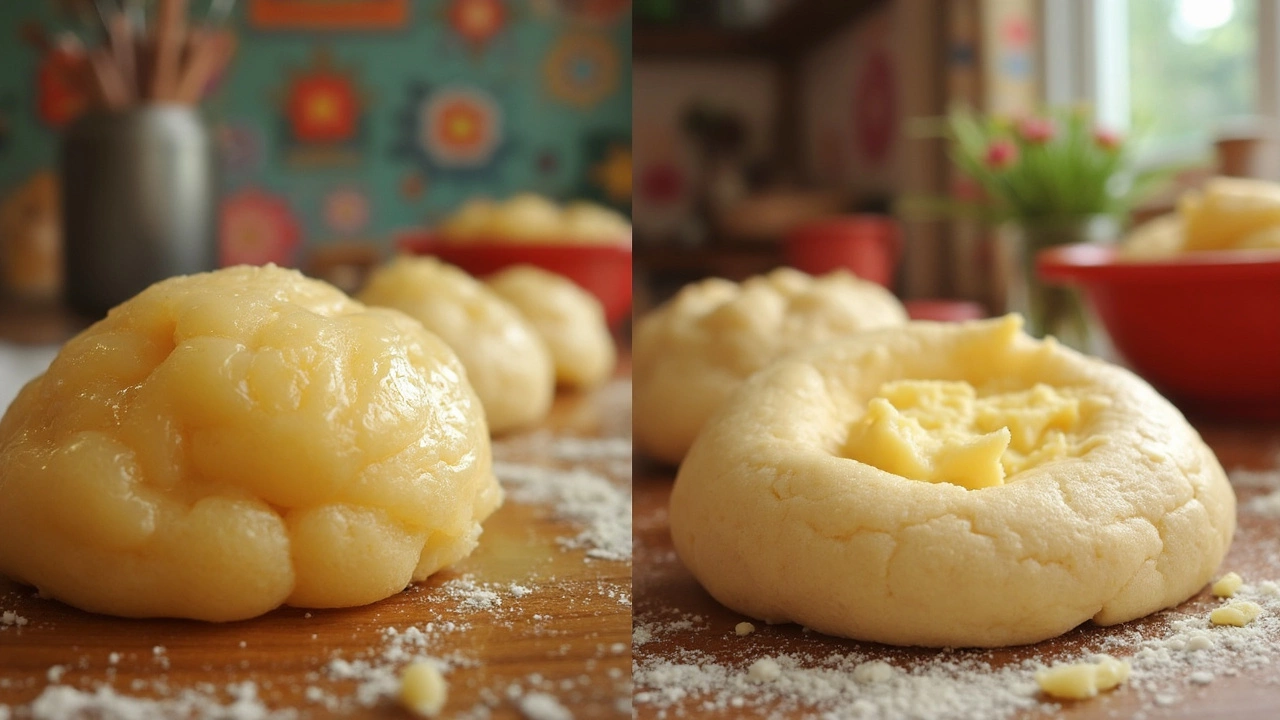
Ever wondered if you should reach for oil or butter when whipping up a batch of cookies? It’s more than just a simple swap; it can totally change your cookie game. Each brings its own unique set of traits to the table, impacting everything from flavor to texture.
Think about those moments biting into a cookie. If you're into chewy, soft bites, oil might be your new secret weapon. It works wonders for those who love cookies that practically melt in the mouth. With butter, though, you're signing up for a richer, more traditional buttery flavor and a bit of crispy edges, something a lot of us grew up adoring.
But it doesn’t stop with taste and texture. Some folks are opting for oil to sidestep the whole saturated fat thing, as it’s generally a bit lighter in that department. Plus, oil can have a longer shelf life than butter, making it an excellent pantry staple for spontaneous baking sessions. Decisions, decisions!
Texture and Taste
When it comes to choosing between oil and butter in cookies, the impact on texture and taste is huge. Butter gives cookies that classic buttery flavor and a slightly crispy edge, thanks to its fat content interacting with sugar during baking. This reaction, known as caramelization, adds those golden hues and a wonderful aroma.
Oil, on the other hand, works differently. Since it stays liquid at room temperature, oil leads to a more consistent dough, resulting in cookies that are incredibly chewy and tender. It doesn’t pack the same flavor punch as butter, but it lets other ingredients, like chocolate chips or vanilla, shine through.
So, if you like your cookies with a bit of crunch and that nostalgic buttery taste, butter’s your go-to. If a soft, melt-in-your-mouth experience is what you’re after, give oil a shot. Here’s a tip: you can even mix them to find your ultimate combo. A little experimentation can lead to that perfect cookie texture tailored just for you!
Health Considerations
Choosing between oil and butter in your cookie recipe might seem just a matter of taste, but there's more to the story if you're keeping an eye on health. So what are the key differences?
Let’s break it down. Butter, loved for its creamy, rich flavor, does have higher saturated fats, which have their own health baggage. If you're watching cholesterol levels or trying to cut back on saturated fats, you might want to think twice before slathering butter into everything.
On the flip side, many oils, like olive or canola, are lower in those saturated fats and instead pack in the healthier unsaturated fats. These can be better for heart health and might even help lower bad cholesterol levels, which is a win if you’re mindful of such things.
But wait, there’s more! You might not know this, but the calories in oil and butter aren’t drastically different. Whether you're using a splash of oil or a pat of butter, they roughly add up, so it's worth measuring out carefully if you're counting calories.
If you're using different kinds of oils, watch out for the ones high in trans fats. They're usually not your friend if health is a concern. Olive oil and coconut oil options, among others, are often praised for their heart health benefits, so they might be your go-to if you're looking for alternatives.
| Type | Saturated Fat (g) | Unsaturated Fat (g) |
|---|---|---|
| Butter (1 tbsp) | 7 | 3 |
| Olive Oil (1 tbsp) | 2 | 10 |
| Canola Oil (1 tbsp) | 1 | 9 |
So there you have it. If your cookies are more than just a treat but also a health choice, considering these factors can help you make a better call. Whether you’re in it for the flavor or the health benefits, knowing what goes into your cookies means you can indulge a bit smarter.

Oil in Cookies
Using oil instead of butter in cookies is a game-changer if you’re after super soft, luscious bites. Since oil is liquid at room temperature, it helps create cookies that stay chewy and moist. You might miss that rich buttery taste, but the texture is something fans rave about.
One perk of opting for oil is the simplicity it brings. There’s no need to wait for it to soften like butter. Also, if you’re vegan or have dairy allergies, oil is an easy go-to. Olive oil or coconut oil adds a mild, pleasant flavor to cookies. Cookie baking adventures just got more exciting!
According to a seasoned baker at The Guardian, "Swapping oil for butter can dramatically change the texture, making each bite feel like you’re sinking your teeth into something irresistibly tender."
If you like experimenting, try different oils. Some oils like canola are quite neutral, letting your other ingredients shine. Meanwhile, oils like sesame or grapeseed might lend little hints of flavor, adding depth to even the simplest recipes.
Here's a quick comparison of some popular oils used in cookies:
| Oil Type | Characteristics | Best Features |
|---|---|---|
| Canola Oil | Neutral, mild flavor | Great for letting other flavors shine |
| Olive Oil | Mild, slightly fruity flavor | Enhances the texture; preferred for Mediterranean cookie recipes |
| Coconut Oil | Slight coconut scent | Adds sweetness and fragrance, great for tropical-themed cookies |
Feeling adventurous? Give oil a shot in your homemade cookies and embrace the chewy, soft goodness that just might change how you bake forever.
Butter in Cookies
When it comes to baking cookies, butter is often the go-to choice for many home bakers. Why? Because it's all about that delicious, rich flavor. It’s like the golden ticket to a classic cookie taste that many of us instantly recognize. The secret lies in the butter's ability to add richness and a tad of crispiness to your cookies, creating a delightful contrast of textures.
Butter is composed of roughly 80% fat, with the remaining portion being water and milk solids. This composition is crucial as it affects how cookies spread during baking. Essentially, the higher fat content in butter helps create that delectable melt-in-the-mouth experience, while the water content allows cookies to puff and stay soft on the inside.
For those looking for a taste that reminds them of Granny’s kitchen, sticking with butter is a no-brainer. It also tends to enhance other flavors, like chocolate or vanilla, better than oil. It’s like your cookies are wearing a flavor amplifier.
But of course, not all butter is created equal. Unsalted butter is usually preferred in baking since it lets you control the saltiness of your cookies better. Also, using softened (not melted) butter is key to achieving that perfect cookie texture, as it helps in incorporating air, making your cookies lighter and fluffier.
Switching from butter can be a hard sell, especially when those buttery aromas fill your kitchen during baking. Just the smell makes it worth sticking to butter for some. Plus, a lot of traditional and holiday recipes call explicitly for butter, promising those familiar and comforting flavors we all love.
| Type of Butter | Purpose |
|---|---|
| Unsalted Butter | Control over salt flavor |
| Salted Butter | Pre-salted, can affect final taste |
| Browned Butter | Nutty aroma, enhances richness |
It's not just about taste either. Did you know that incorporating browned butter—a butter that’s cooked until it turns golden brown and nutty—into your cookie dough can elevate your cookies to gourmet status? The flavor complexity it adds is next level!

Experimenting with Flavors
Diving into the world of cookie baking, the choice between oil and butter opens up a whole field of flavor possibilities. Why stick to plain when you can level up your cookie game with some creative tweaks?
First off, consider incorporating flavored oils. Imagine a cookie with a hint of coconut oil or a citrusy note from lemon-infused oil. These cookie baking tips can give you a surprising new flavor dimension. Coconut oil, for instance, pairs wonderfully with chocolate chips, adding a tropical kick that’s irresistible.
If you’re loyal to butter but still crave a twist, try browned butter. Sounds fancy, but it’s simply a matter of gently heating the butter until it turns golden and aromatic. This little step adds a nutty, caramel-like depth to your cookies, transforming a basic recipe into gourmet-quality treats.
- Use olive oil for a subtle, savory taste in cookies with herbs or nuts.
- Infuse butter with spices like cinnamon or cardamom before adding it to the dough.
- Experiment with different types of sugar (brown, white, demerara) along with your choice of fat for varied textures and tastes.
Trying out gluten-free or vegan cookies? Oils are perfect for these versions because they naturally meet dietary needs while offering flexibility. Just swap in the right oil for your flavor and health preferences, like avocado oil for a buttery texture without the actual butter.
So, the next time you pull out that mixing bowl, think beyond the basics. Homemade cookies are your canvas, and whether you choose oil or butter in cookies, there's always room to play around and discover something new and tasty.





